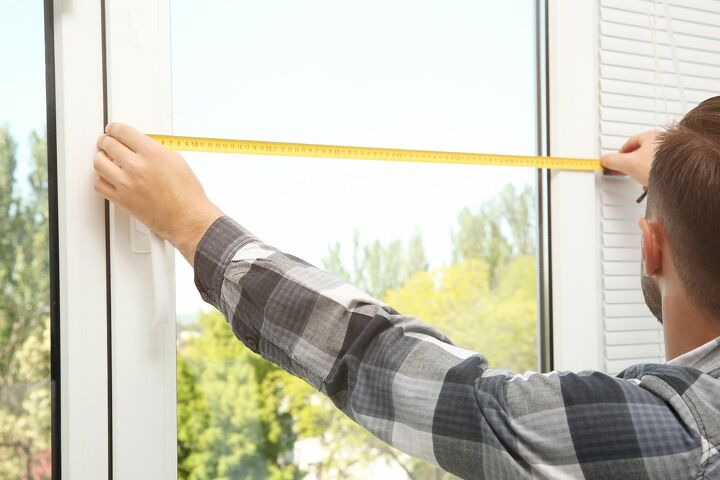Standard Blind Sizes (with Drawings & Measurements)

Window blinds are a great way to add privacy to your home and reduce glare from the sun. You can find plastic, vinyl, wood, and metal blinds with horizontal slats. One of the most cost-effective ways to cover your windows is with standard blind sizes.
Standard blind sizes coincide with standard window sizes, with widths 24 to 60 inches and heights from 36 to 72 inches. Common sizes for slats are ½”, 1″, and 2″, with wider slats working better with deeper windows. If your window is slightly smaller than a standard size, most companies can trim your blinds to fit.
Once you know the size of your window, you can choose the appropriate size of blinds. Opting for standard blind sizes saves you money and makes installation easy. Keep reading to get the lowdown on standard blind sizes.
What Are the Standard Blind Sizes?
Standard blind sizes match up with standard window sizes. Therefore, it makes it easy to find blinds to fit your existing standard windows.
The most common style of blinds features horizontal slats, such as mini blinds and Venetian blinds. You’ll find both in several sizes and with various slat sizes.
We’ll look a bit closer at slat sizes in a moment. But, first, let’s focus on the width and height of standard blind sizes.
What Size Are Mini Blinds?
Mini blinds are an easy, low-cost way to add privacy and shade to a room quickly. You can find them in various materials and colors to go with your home’s decor.
Mini blinds come in standard sizes to fit the most common window sizes.
The most common widths for mini blinds are:
- 24 inches
- 36 inches
- 48 inches
- 60 inches
The most common heights for mini blinds are:
- 36 inches
- 48 inches
- 60 inches
- 72 inches
How Big Are Venetian Blinds?
You’ll find Venetian blinds in sizes that match the dimensions of mini blinds but likely have some wider options. Both styles work similarly.
The main difference is Venetian blinds have wider slats. Therefore Venetian blinds are generally a better choice for larger windows that can accommodate the wider slats.
The standard widths of Venetian blinds can range from 2 to 8 feet wide and 1 to 8 feet tall. This broad range is because different window styles feature various dimensions. Typically, you can find standard blinds to match these common window sizes.
What Are the Standard Sizes of Vertical Blinds?
Although not as popular as horizontal blinds, vertical blinds are often used to cover various dimensions of sliding glass doors. You can find vertical blinds in standard sizes just like you can window blinds.
The standard size for off-the-shelf vertical blinds ranges from 24″ by 72″ to 72″ by 72″. These measurements usually coincide with standard sliding glass doors.
How Do You Measure for Blinds?
When purchasing new blinds, getting the appropriate size is critical, which means taking accurate measurements. In many cases, if you’re purchasing standard blind sizes for standard windows, it will be easy to do.
Many manufacturers will provide information about their blinds, saying which size window they will fit. You can match your window size to their chart to get the right blinds. But, there are still a few things you need to know to ensure you get the correct size.
Measuring for Inside-Mount Blinds
Some window blinds mount within the window frame. These inside-mount blinds will be different from those that mount outside the window.
To measure for inside mount blinds, measure horizontally across the inside of the window. Take three measurements — one at the top, one at the middle, and one at the bottom. Use the smallest measurement as your blind width, keeping in mind you’ll likely have a slight light gap.
To determine the necessary height, measure inside the window vertically at the right, left, and in the middle. Use the smallest of the three measurements. You’ll also need the depth of your window frame to ensure you can fit the inside mount.
Measuring for Outside-Mount Blinds
To determine the width of outside-mount blinds, take your measurements from the outside of the window frame. Get three measurements for the width (the top, middle, and bottom). Take the widest measurement.
For the height, get a measurement vertically on the right and left. This time, for height, record the tallest measurement.
Each company will have its own guide for measuring its blinds. Therefore, always follow the instructions that align with the specific blinds you’re purchasing. In some cases, you might need to subtract a certain amount from your measurements and compare it to a size chart.
What If Standard Blind Sizes Won’t Fit My Window?
If you can’t find a standard blind size for your window, you have a couple of options. First, is your window smaller than standard-sized blinds?
You can likely have the manufacturer cut the blinds down to size. If so, opt for the standard blinds that are slightly larger than your window. This will be much more affordable than getting custom blinds made.
Measuring for Custom Size Blinds
If you need to get custom blinds, you’ll need to measure precisely to get the right fit. Once the blinds are made, you might not be able to return them if there’s an error on your end.
Measuring for custom blinds is the same as if you measured for standard. You need to measure your existing window. However, do you plan to let your outside-munt blinds extend past the window?
In this case, take your measurement from above the window to where you want the blinds to stop. Take into consideration the window sill and any molding that would stick out and interfere with the blinds.
Will Home Depot or Lowe’s Cut My Blinds for a Custom-Fit?
Lowe’s and Home Depot will typically cut blinds you buy in-store to your specified size. Usually, this service is at no extra cost, but make sure you’re sure about your measurements.
Since each store can vary on its policies, it’s wise to check with your location before assuming they’ll cut your blinds.
Can I Cut My Own Blinds to Get the Right Size?
If you purchase blinds and discover they’re too long for your window, you can cut them down yourself. Doing this will likely void any warranty you have on the blinds.
The best way to cut down blinds is to close them and bungee them or secure them together. Then, attach them to your work table before measuring and making your cut.
You can see the process in the video below. But as you’ll also see, having the right tools for the job will make things even easier.
Video: Cutting Down the Width of Horizontal Blinds
Are Motorized Blinds a Different Size?
Motorized blinds come in similar standard sizes to regular blinds since they also need to fit standard windows. The biggest difference is you can operate these blinds with a remote or your smart device. You don’t need any cords or rods, etc.
What Are Blind Slat Sizes?
As mentioned previously, another important measurement to consider when shopping for blinds is depth. This measurement directly affects the slat size you’ll choose for your blinds. Common slat sizes are ½”, 1″, 2″, and 2 ½”, with mini blinds usually having smaller slats.
Choosing the Right Slat Size
Smaller slats typically work better for smaller windows. Conversely, larger slats work better for medium to more oversized windows. The wider the slat, the heavier your blinds will be.
However, smaller slats will typically block light better since they’re closer together. When determining your slat size, remember to measure your window frame depth. For example, if the depth is only 1 ½ inch, a 2-inch slat would stick out past the frame.
Summarizing Blind Sizes
Choosing blinds for standard windows is usually pretty straightforward since standard blind sizes match standard window sizes. Standard blinds range from 24 to 60 inches wide and 36 to 72 inches tall. If you get blinds larger than your window, you can cut them down or have the company do so.
You need to measure the depth of your window frame to determine the appropriate slat size. Common sizes for slats are ½”, 1″, and 2″, and wider slats are better for larger windows.

Stacy Randall is a wife, mother, and freelance writer from NOLA that has always had a love for DIY projects, home organization, and making spaces beautiful. Together with her husband, she has been spending the last several years lovingly renovating her grandparent's former home, making it their own and learning a lot about life along the way.
More by Stacy Randall






























